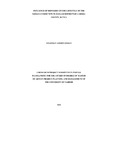| dc.contributor.author | Osman, Suleiman A. | |
| dc.date.accessioned | 2014-08-05T12:17:34Z | |
| dc.date.available | 2014-08-05T12:17:34Z | |
| dc.date.issued | 2014 | |
| dc.identifier.citation | Master Of Arts In Project Planning And Management, University of Nairobi, 2014 | en_US |
| dc.identifier.uri | http://hdl.handle.net/11295/73661 | |
| dc.description.abstract | The purpose of the study was to look into the influence of the refugees on the lifestyle
of the local community in Dadaab. Lots of focus was on the on the number of refugee
in Dadaab refugee camps to that of the local community in terms of population. An
analysis into how the frequency of the refugee arrival has affected the lifestyle of the
local community in terms of demographic distribution and their origin and how the
socio-economic environment has changed since the camps were set up in the area
were also of great concern. Through observation schedules and interviews with all the
stakeholders in the management of refugee issues, all the above outlined objectives
were taken care of. The establishment of the five Dadaab refugee camps was
presented to the host Somali community drastic changes that have influenced their
lifestyle.
The study helped in providing proposal for addressing the problems in the lifestyle of
the local community for better improvements in terms of services and cordial
relationships. The study employed a descriptive survey design which involved
descriptive methods. Simple random sampling technique was used to select the
respondents. Both primary and secondary of data collection was used. Primary data
was collected using questionnaire survey and in-depth interview. Both face validity
and content validity was checked and a necessary adjustment of the instrument was
made to enhance validity.
The researcher obtained an introduction letter from the University of Nairobi College
to obtain a research permit from the national council for science and technology for
data collection. Qualitative data was analyzed qualitatively using content analysis
based on analysis of meanings and implications emanating from respondents
information and documented data.
The study established that the lifestyle of local communities in Dadaab was
influenced negatively by refugees in Humanitarian Agency camps. Discrimination in
accessing basic needs, education, and health care services influenced their daily
lifestyle since Agencies established camps in Dadaab. Beneficiaries of United Nations
Agencies were refugees but not the local community.
The study recommended that the Government in collaboration with Humanitarian
Agencies should establish appropriate measures to give long term solutions to
challenges experienced by local communities like expanding financial budgets in
education sponsorships of the local community and introducing financial incentives to
support small scale enterprises of both the local communities and refugees thus
cohesiveness of the two parties. | en_US |
| dc.language.iso | en | en_US |
| dc.publisher | University of Nairobi | en_US |
| dc.title | Influence Of Refugees On The Lifestyle Of The Somali Community In Dadaab District Of Garissa County, Kenya | en_US |
| dc.type | Thesis | en_US |
| dc.type.material | en_US | en_US |

